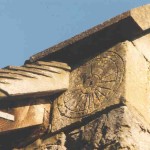The British Sundial Society is compiling a register of all the Mass dials in the country. At present it contains records of over 3,000 Mass dials from across the UK. We know that there are many more to be recorded and it is likely that there are still many more to find.
A concise version of the full Mass Dial Register made in 2018 is available on DVD or as an abridged booklet from the BSS Shop.
About Mass Dials
Mass dials, also known as Scratch dials, are a type of medieval dial (1100 to 1600) found on the south side of many churches. They tend to be fairly small and found on the walls, buttresses, windows and doorways of a church. They are called Mass dials because it is thought that some showed the time of the Mass and other services held during the day. They are also known as Scratch dials because many of these dials are quite crudely scratched into the stone.
The hole in the centre of the dial would once have contained a horizontal wooden or metal rod that cast a shadow. This rod is known as a gnomon (pronounced No Mon). A gnomon hole might be found in the mortar joint between two stone blocks, in the same block as the dial or in the block above the dial.
Reporting
If you find a Mass dial, please send a good ‘straight on’ photograph of the dial labelled with the name and address of the church to Ben Jones massdials@sundialsoc.org.uk. Good photographs of any scratch/mass dial, even previously recorded dials, are much appreciated.
If possible, please could you complete as much of the Mass Dial recording form as you are able to: see explanatory notes for more information. The form can be saved for your own records and a copy sent, along with the pictures, to massdials@sundialsoc.org.uk. A more general picture of the church if it shows the dial and its location can be very useful. If you wish to send many reports or large photographs please use a bulk transfer service such as WeTransfer.
Ben Jones – BSS Mass Dials Registrar.
Further reading
BSS Bulletins
The BSS Bulletin has published many articles about Mass Dials: the full text of Bulletins from 1989 to 2010 can be searched and read online and the cumulative contents of all issues to date is also available.
Between 2007 and 2012 the Bulletin included a series of articles by Chris Williams that provide a comprehensive analysis of the Society’s Mass Dial Register with insights into the prevalence, use, appearance, evolution and eventual fate of scratch dials. For convenience, the full set of articles is available as a single document.
Books
Time Reckoning in the Medieval World, David Scott and Mike Cowham. BSS Monograph No.8. BSS Sales £17-50.
De Cursu Solis: Medieval Azimuthal Sundials. BSS monograph No.10. 2012.
Mass Dials in Yorkshire Churches. BSS monograph No 3. BSS Sales £6-50.
The ancient sundials of Ireland, Mario Arnaldi, BSS Sales £6-50.
Please visit the BSS Shop for more information.
CD-ROM
Mass Dials of Lincolnshire: BSS Sales £15.
Please visit the BSS Shop for more information.
Out of print books
Scratch Dials, their description and history, Dom Ethelbert Horne, Simpkin Marshall Ltd, 1929.
Sundials Incised Dials or Mass Clocks, Arthur Green, SPCK London 1926/1978.
Origins and Use of Church Scratch-Dials. T.W. Cole, 1935
Mass dials can be found in unlikely places: inside churches and on north walls where the sun rarely shines. This is probably due to the stone blocks having been re-used in the rebuilding of the church. Dials can be found inside porches suggesting that the porch was built sometime after the dial was made. The Mass dial at Little Missenden (Fig 3) is now upside down as well as inside the church.
Mass dials vary in size. The dial at Boddington, Glos. (Fig 4) is 70mm diameter while the dial at Leckhampton, Glos. (Fig 5) is 400mm diameter. Most Mass dials are not much more than 200mm diameter.
Not many Mass dials have their ‘hour’ lines numbered. The dial at Bibury, Glos (Fig 6) has Roman numerals and the dial at Sandhurst, Glos. (Fig 7) has Arabic numerals.






